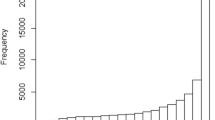Abstract
Many researchers have theorized or demonstrated a relationship between tenor and vehicle similarity and the judged quality of metaphors. In four experiments, each using different materials, the relationship between similarity and metaphoric quality was examined. Undergraduates in two different institutions rated: (1) the similarity of tenor and vehicle concepts, (2) the quality of metaphors in isolated, formulaic, sentences (the sort of materials used in previous experiments), or (3) the quality of the same metaphors in various extended, natural contexts. Average ratings of all three variables were determined for each metaphor. In all four experiments, similarity was highly positively correlated with the quality of metaphors in isolated, formulaic contexts, but similarity was either not correlated highly (Experiment 3) or not correlated at all (Experiment 1,2 & 4) with the quality of metaphors in extended, natural contexts. In three of the experiments, the quality of metaphors in isolated, formulaic sentences was not significantly correlated with the quality of metaphors in extended context.
Similar content being viewed by others
References
Abrams, M. H.A glossary of literary terms, 3rd ed.. New York: Holt, Rinehart & Winston, Inc., 1957.
Asch, S. E. The metaphor: A psychological inquiry. In R. Taguiri & L. Petrullo (Eds.),Person perception and interpersonal behavior. Stanford, California: Stanford University Press, 1969 (Originally Published, 1958).
Black, M.Models and metaphors. Ithaca, New York: Cornell University Press, 1962.
Boyle, T. C. John Barleycorn lives.Atlantic, January 1979,243, 67–72.
Brooks, C.The well wrought urn. New York: Harcourt, Brace & World, Inc., 1947.
Brooks, C. Metaphor, paradox, and stereotype.British Journal of Aesthetics, 1965,5, 315–328.
Brown, R.Words and things. New York: The Free Press, 1958.
Chomsky, N.Aspects of the theory of syntax. Cambridge, Mass. The M.I.T. Press, 1965.
Crane, S. The blue hotel. InGreat short works of Stephan Crane. New York: Harper & Row, 1965.
Deese, J.The structure of associations in language and thought. Baltimore: Johns Hopkins, 1965.
Fillenbaum, S., & Rapoport, A.Structures in the subjective lexicon. New York: Academic Press, 1971.
Gilman, C. P.The yellow wallpaper. Boston: Small, Maynard, & Co., 1899.
Harris, R. J. Memory for literary metaphors.Bulletin of the Psychonomic Society, 1979,13, 246–249.
Harwood, D. L., & Verbrugge, R. R.Metaphor and the asymmetry of similarity. Paper presented at the meeting of the American Psychological Association, San Francisco, California, August 27, 1977.
Honeck, R. P., Voegtle, K., Dorfmueller, M. A., & Hoffman, R. R. Proverbs, meaning, and conceptual groups. In R. P. Honeck & R. R. Hoffman (Eds.),Cognition and figurative language. Hillsdale, New Jersey: Lawrence Erlbaum Associates, 1980.
Johnson, M. G., & Malgady, R. G. Toward a perceptual theory of metaphoric comprehension. In R. P. Honeck & R. R. Hoffman (Eds.),Cognition and figurative language. Hillsdale, New Jersey: Lawrence Erlbaum Associates, 1980.
Koen, F. An intra-verbal explication of the nature of metaphor.Journal of Verbal Learning and Verbal Behavior, 1965,4, 129–133.
Kozlowski, L. T. Similarity of affective meaning and the evaluation of metaphor.Perceptual and Motor Skills, 1975,41, 787–790.
Loewenberg, I. Truth and consequences of metaphors.Philosophy & Rhetoric, 1973,6, 30–46.
Malgady, R. G., & Johnson, M. G. Modifiers in metaphors: Effects of constituent phrase similarity on the interpretation of figurative sentences.Journal of Psycholinguistic Research, 1976,5, 43–52.
McCabe, A.A rhetoric of metaphor. Unpublished doctoral dissertation, The University of Virginia, 1980.
McNeill, D. A. A study of word associations.Journal of Verbal Learning and Verbal Behavior, 1966,5, 548–557.
Ortony, A.Beyound literal similarity. Technical Report No. 105, Champaign, Illinois: University of Illinois, October, 1978.
Ortony, A. Beyond literal similarity.Psychological Review, 1979,86, 161–180.
Ortony, A., Reynolds, R. E., Arter, J. A. Metaphor: Theoretical and empirical research.Psychological Bulletin, 1978,85, 919–943.
Ortony, A., Schallert, D. L., Reynolds, R. E., & Antos, S. J. Interpreting metaphors and idioms: Some effects of context on comprehension.Journal of Verbal Learning and Verbal Behavior, 1978,17, 465–477.
Richards, I. A.The philosophy of rhetoric. London: Oxford University Press, 1936.
Ricoeur, P.The rule of metaphor (R. Czerny, with K. McLaughlin & J. Costello, translators), Toronto, Canada: University of Toronto Press, 1975.
Steinbeck, J.East of Eden. New York: Bantam Books, Inc., 1955.
Tourangeau, R., & Sternberg, R. J.Understanding and appreciating metaphors. NR150-412 ONR Technical Report # 11, New Haven: Department of Psychology, Yale University, 1978(a).
Tourangeau, R., & Sternberg, R. J.Aptness in metaphor. NR150-412 ONR Technical Report # 13, New Haven: Department of Psychology, Yale University, 1978(b).
Tourangeau, R., & Sternberg, R. J. Aptness in metaphor.Cognitive Psychology, 1981,13, 27–55.
Tversky, A. Features of similarity.Psychological Review, 1977,84, 327–352.
Verbrugge, R. R.The comprehension of analogy. Paper presented at the meeting of the Midwestern Psychological Association, Chicago, May 1–3, 1975(a).
Verbrugge, R. R.Perceiving invariants at the invitation of metaphor. Paper presented at the meeting of the American Psychological Association, Chicago, August 30, 1975(b).
Verbrugge, R. R. On metaphoric and metonymic modes of growth. In H. Gardner (Chair),Thinking with the left hand: Children's understanding of analogy and metaphor. Symposium presented at the meeting of the Society for Research in Child Development, New Orleans, March 1977(a).
Verbrugge, R. R. Resemblances in language and perception. In R. E. Shaw & J. D. Bransford (Eds.),Perceiving, acting, and knowing: Toward an ecological psychology. Hillsdale, New Jersey: Lawrence Erlbaum Associates, 1977(b).
Verbrugge, R. R. Transformations in knowing: A realist view of metaphor. In R. P. Honeck & R. R. Hoffman (Eds.),Cognition and figurative language. Hillsdale, New Jersey: Lawrence Erlbaum Associates, 1980.
Wheelwright, P.Metaphor and reality. Bloomington, Indiana: Indiana University Press, 1962.
Author information
Authors and Affiliations
Additional information
Experiments 1 and 2 of this study were part of a master's thesis completed at the University of Virginia, 1977. Experiment 3 was part of a doctoral dissertation completed at the University of Virginia. 1980.
Rights and permissions
About this article
Cite this article
McCabe, A. Conceptual similarity and the quality of metaphor in isolated sentences versus extended contexts. J Psycholinguist Res 12, 41–68 (1983). https://doi.org/10.1007/BF01072713
Accepted:
Issue Date:
DOI: https://doi.org/10.1007/BF01072713




